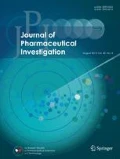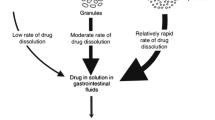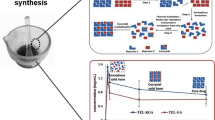Abstract
The purpose of this study was to evaluate the effect of the method of excipients addition (intra-granularly or extra-granularly) and type of excipients on the stability of pramipexole dihydrochloride monohydrate (PRM) tablets. Corn starch, pre-gelatinized starch, dibasic calcium phosphate, microcrystalline cellulose or lactose anhydrous were used as excipients. PRM tablets were prepared by a wet granulation method and stability tests were performed at 40 °C/75 % RH, 60 °C or 80 °C. X-ray diffraction (XRD), scanning electron microscopy (SEM) and energy dispersive X-ray spectroscopy (EDS) were used to characterize the physicochemical properties of PRM. While PRM raw material was inherently stable, decreased content and increased related substances were detected for PRM tablets. By incorporating pre-gelatinized starch with the drug intra-granularly, the most stable PRM tablet formulation was achieved. The results of XRD, SEM and EDS suggested that PRM was at the surface of granules with an amorphous state. In general, as the amorphous form is more reactive than the crystalline form, compatibility between PRM and the excipient plays an important role for drug stability in the tablet. Therefore, it is essential to select proper excipients to improve stability of PRM tablets prepared using the wet granulation method.








Similar content being viewed by others
References
Airaksinen S, Karjalainen M, Kivikero N, Westermarck S, Shevchenko A, Rantanen J, Yliruusi J (2005) Excipient selection can significantly affect solid-state phase transformation in formulation during wet granulation. AAPS PharmSciTech 6:311–322
Badawy SF, Gawronski AJ, Alvarez FJ (2001) Application of sorption–desorption moisture transfer modeling to the study of chemical stability of a moisture sensitive drug product in different packaging configurations. Int J Pharm 223:1–13
Badawy S, Vickery R, Shah K, Hussain M (2004) Effect of processing and formulation variables on the stability of a salt of a weakly basic drug candidate. Pharm Dev Technol 9:239–245
Corrigan MH, Denahan AQ, Wright CE, Ragual RJ, Evans DL (2000) Comparison of pramipexole, fluoxetine, and placebo in patients with major depression. Depression Anxiety 11:58–65
Cunningham CR, Kinsey BR, Scattergood LK (2001) Formulation of acetylsalicylic acid tablets for aqueous enteric film coating. Pharm Technol Eur 13:44–53
Delwiche SR, Pitt RE, Norris KH (1991) Examination of starch-water and cellulose-water interactions with near infrared (NIR) diffuse reflectance spectroscopy. Starch 43:415–422
Du J, Hoag SW (2001) The influence of excipients on the stability of the moisture sensitive drugs aspirin and niacinamide: comparison of tablets containing lactose monohydrate with tablets containing anhydrous lactose. Pharm Dev Technol 6:159–166
Heidemann DR, Jarosz PJ (1991) Preformulation studies involving moisture uptake in solid dosage forms. Pharm Res 8:292–297
Łaszcz M, Trzcińska K, Kubiszewski M, Kosmacińska B, Glice M (2010) Stability studies and structural characterization of pramipexole. J Pharm Biomed 53:1033–1036
Leentjens AG, Koester J, Fruh B, Shephard DS, Barone P, Houben JG (2009) The effect of pramipexole on mood and motivational symptoms in Parkinson’s disease: a meta-analysis of placebo-controlled studies. Clin Ther 31:89–98
McCormack PL, Siddiqui MA (2007) Pramipexole: in restless legs syndrome. CNS drugs 21:429–437
Mierau J, Schingnitz G (1992) Biochemical and pharmacological studies on pramipexole, a potent and selective dopamine D2 receptor agonist. Eur J Pharmacol 215:161–170
Murikipudi V, Gupta P, Sihorkar V (2011) Efficient throughput method for hygroscopicity classification of active and inactive pharmaceutical ingredients by water vapor sorption analysis. Pharm Dev Technol 18:348–358
Naidu KR, Kale UN, Shingare MS (2005) Stability indicating RP-HPLC method for simultaneous determination of amlodipine and benazepril hydrochloride from their combination drug product. J Pharm Biomed 39:147–155
Q1A(R2) (2003) Q1A(R2) ICH guideline. Stability testing of new drug substances and products. International Conference on Harmonization, IFPMA, Geneva
Rowe RC, Sheskey PJ, Owen SC (2006) Handbook of pharmaceutical excipients. Pharmaceutical Press, London
Schilling JC, Adamus WS, Palluk R (1992) Neuroendocrine and side effect profile of pramipexole, a new dopamine receptor agonist, in humans. Clin Pharmacol Ther 51:541–548
USP (2013) USP36-NF31, US Pharmacopeial Convention, Rockville, MD
Vaucher LC, Paim CS, Lange AD, Schapoval EES (2009) LC method for telithromycin in tablets: a stability-indicating assay. Int J Pharm 366:82–87
Villalobos-Hernandez J, Villafuerte-Robles L (2001) Effect of carrier excipient and processing on stability of indorenate hydrochloride/excipient mixtures. Pharm Dev Technol 6:551–561
Wernersbach HW (2008) Process for preparing pramipexole dihydrochloride tablets with high storage stability. WO Patent 2,008,023,027
Wong KS, Lu CS, Shan DE, Yang CC, Tsoi TH, Mok V (2003) Efficacy, safety, and tolerability of pramipexole in untreated and levodopa-treated patients with Parkinson’s disease. J Neurol Sci 216:81–87
Acknowledgments
This article does not contain any studies with human and animal subjects performed by any of the authors. All authors (J.Y.Kim, J.M.Ha, Y.S. Rhee, C.W. Park, S.C, Chi, and E.S. Park) declare that they have no conflict of interest. This work was supported by the Korean Health Technology R&D Project, Ministry for Health and Welfare (A092018) and by the Ministry of Education, Science and Technology (MEST), the Ministry of Knowledge Economy (MKE) through the fostering project of HUNIC.
Author information
Authors and Affiliations
Corresponding author
Rights and permissions
About this article
Cite this article
Kim, JY., Ha, JM., Rhee, YS. et al. Influence of pharmaceutical excipients on stability of pramipexole dihydrochloride monohydrate in tablets. Journal of Pharmaceutical Investigation 44, 177–185 (2014). https://doi.org/10.1007/s40005-013-0113-0
Received:
Accepted:
Published:
Issue Date:
DOI: https://doi.org/10.1007/s40005-013-0113-0




